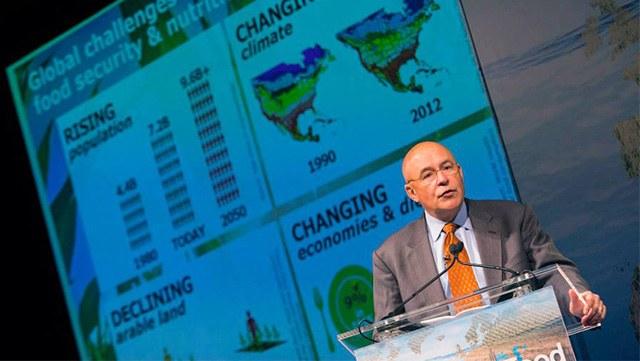
By Molly Nance
As the world population soars toward 9 billion people, the demand for food is expected to more than double. Lack of water is a critical constraint to increasing food production, particularly as climate change makes water even scarcer.
Big Data is helping to meet that challenge. Experts from around the world gathered in Seattle this week at the Water for Food Global Conference to discuss ways to harness this data revolution in agriculture. Hosted by the Robert B. Daugherty Water for Food Institute at the University of Nebraska in association with the Bill & Melinda Gates Foundation, the conference focused on mobilizing Big Data to improve global water and food security.
Our speakers discussed five data tools for promoting water and food security:
- Global Yield Gap and Water Productivity Atlas: Are we on track to feed 9 billion people by 2050? “No!” said University of Nebraska-Lincoln agronomist Ken Cassman, a DWFI fellow. But we can get back on track. Freely available data provided by the public sector is key. He described an open-data effort he’s leading to identify existing farmland with the capacity to produce much higher, stable yields. The Global Yield Gap and Water Productivity Atlas is a major global collaboration in which researchers are gathering and analyzing satellite, atmospheric, soil and historic data to identify farmland where significant gaps exist between actual and potential yields for different crops.The mapping tools and models will help make global food security predictions and, even more importantly, help individual countries identify yield potential to improve policies, increase food production, conserve water and better strategize resource allocations. Increasing yields on existing farmland is necessary to help ensure natural areas aren’t sacrificed to agricultural production in the coming decades, Cassman said.
- Biotechnology: Robert T. Fraley, of Monsanto Corp., was also optimistic about meeting future food needs. Advances in plant breeding, biotechnology and agronomic practices are transforming agriculture, particularly helping to strengthen crop resiliency to drought and pests. Data science is the engine driving advances in biotechnology, he said.
- Greenhouses: How is it possible to produce food without consuming water? Pasquale Steduto, of the UN’s Food and Agriculture Organization, described an FAO project to develop the next generation in greenhouse farming. This sustainable agricultural solution achieves 90 percent reductions in water consumption compared to open farming by recycling water normally lost to plant transpiration and evaporation.They’re not for everyone, he said. But for arid countries that rely heavily on importing food, greenhouses can increase food security and water conservation, as well as reduce the vulnerability to food crises. The FAO is currently working on a pilot project in the United Arab Emirates.
- Water meters: Globally, agriculture consumes 70 percent of all freshwater withdrawals, primarily for irrigation. In many water scarce areas, water is pumped from aquifers at unsustainable levels. Data regarding aquifer conditions, groundwater withdrawals and other metrics are critical for water managers to prevent catastrophic depletions.Speakers from regions as diverse as Nebraska and Oman described their experiences with water metering. Though water metering to potentially regulate use is sometimes unpopular, it’s the only way to have a fair and transparent accounting of water use and to ensure that quotas are adhered to, said Wolfgang Kinzelbach, of the Institute of Environmental Engineering and Swiss Federal institute of Technology in Zürich.
- Global Burden of Disease: A panel of public health and child development experts enumerated the ways in which health, food production and water are linked. Emmanuela Gadidou, of the University of Washington, said water influences health through food production and diarrheal diseases. She described the Global Burden of Disease, a data-driven effort to provide detailed health information that countries and others can use to improve health conditions and the performance of their health systems.
To view more photos, visit the Water for Food Facebook page.
Video from the conference is available on the Water for Food Youtube page.
Molly Nance is director of communication and public relations at the Robert B. Daugherty Water for Food Institute at the University of Nebraska, a research, education and policy analysis institute created to address the global challenge of achieving food security with less pressure on water resources.
[Image credit: Craig Chandler / University of Nebraska-Lincoln]
TriplePundit has published articles from over 1000 contributors. If you'd like to be a guest author, please get in touch!














